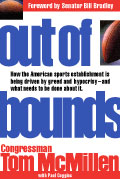Ministry of Sports to Combat Childhood Obesity
Opinion
From The Hill
by Tom McMillen
The nation’s childhood obesity epidemic is finally beginning to draw serious attention, and not a moment too soon. However, our efforts to deal with this epidemic are far too focused on what kids eat and not enough on getting them up on their feet.
Over 25 million American children over the age of six are obese or overweight. Among children ages six to eleven this represents a five-fold increase in just the last 30 years. This youth obesity epidemic is estimated to result in a 300 percent increase in national healthcare costs.
Proper nutrition is critical to combating obesity, however we can’t effectively fight this epidemic unless we deal with the corresponding problem of youth inactivity.
Research has shown that lack of physical activity may be a more significant factor in contributing to childhood obesity than even bad diet. Other research in adults indicates that poor fitness is a more significant predictor of death than obesity generally, diabetes and other causes. In other words, the most important thing we can do for the health of our kids is to get them up off the couch.
Sadly, twenty-five percent of our kids do not participate in any free-time physical activity. Ninety-two percent have no daily physical education or activity year round. And, our kids have figured out that with a flick of the wrist they can play their favorite “get active” video games sitting on the couch.
The lack of focus on physical activity is not surprising. It is easy, and to certain degree right, to target food and beverage companies for what they are feeding our children. However, it is much more difficult to point fingers at over-worked parents and struggling schools.
Perhaps the most important reason why we aren’t focused on youth activity as a nation is because no one is in charge and virtually no money in it. The United States has always favored a weak, decentralized model of governance and funding for youth sports and fitness. Almost every other nation has a cabinet or sub cabinet level ministry of sports to make grassroots physical activity a national priority. The First Lady has made youth activity one of the four main goals of her initiative, but there is only so much she can do without a strong bench and real budget behind her.
Within our federal ranks the lead entity dedicated to promoting sports and physical fitness is the President’s Council on Physical Fitness and Sports. The modern-Council was created by President Kennedy during an era when touch football and 50 mile hikes were in vogue. During its early years the Council was housed within the White House and had real resources behind it.
Unfortunately, over the years the President’s Council has declined in relevance through budget cutbacks and bureaucratic infighting. Today, it is a small advisory agency relegated to the Department of Health and Human Services. It has an annual budget of just over a $1 million, barely enough to keep the program running. At the same time, legal restraints prevent the Council from aggressively partnering with the private sector to promote physical activity. Even the Council’s fitness badge and test, once of the most recognizable youth “brands,” needs to be updated. Additionally, with dramatically reduced physical education programs in our schools there is little infrastructure to support the test and badge. As a result, at a time when we need it most, the Council has virtually no impact on the physical welfare of our youth.
We need an effective Council and ongoing Federal effort to fight the inactivity and obesity epidemic.
First and foremost, the Council needs resources. Most nations fund sports in a true pyramid fashion, with lots of money at the base for youth grassroots participation and little at the top for elite athletics. In America, we have inverted the pyramid. We provide little at the base for community sports and school physical education programs for our children, while lavishing public subsidies at the top, for example giving vast amounts of tax dollars to build professional sports stadiums. If we want to win the fight against child obesity, we must flip this pyramid and devote real resources to youth grassroots efforts.
Since serving as Co-Chair of the President’s Council under President Clinton, I have worked closely with Senator Mark Warner and Congressman John Sarbanes to develop legislation that would create a Congressionally authorized National Foundation on Physical Fitness and Sports. The Foundation’s mission would be to generate private sector support to supplement the Council’s programs and budget. This Foundation would be modeled on existing ones, like the National Parks Foundation and the National Institutes for Health Foundation. No federal dollars would be required. This legislation, H.R. 4322 in the House and S. 1275 in the Senate, is currently pending in Congress. Its passage would go a long way to funding a national commitment for youth sports and fitness and would bring much needed resources to fighting this epidemic.
Although I believe a U.S. Ministry of Sports focused on our youth would be the best policy path for our government in light of the rapidly declining fitness levels of our youth, the National Foundation on Physical Fitness and Sports would at least begin to focus our national priorities on critical youth sports and fitness programs—programs that will be critical in the fight against youth inactivity and obesity.
http://thehill.com/opinion/op-ed/92699-ministry-of-sports-to-combat-childhood-obesity








